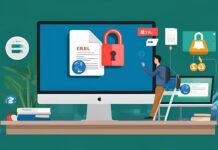Cybersecurity is an issue that affects every business and should be a top priority for any company. Cyber attacks are happening more frequently, and cybercriminals have become more sophisticated in their methods. During the past year, 34.5% of respondents revealed that cybercriminals targeted their organizations’ financial data.
As a result, data breaches are becoming increasingly common. If you’re responsible for safeguarding your organization’s sensitive information, you must implement best practices to protect against these cyber threats.
Understanding Cybersecurity Threats
To understand the risks to your company and its data, it’s essential to understand the different types of cybersecurity threats.
- Cybersecurity threats are any actions or behaviors that can lead to information security breaches. Threats come in many forms: malicious software, denial-of-service attacks, phishing emails, and viruses, the list goes on. You can also consider threats like fire or theft and natural disasters that could cause damage if left unchecked.
- Cybersecurity attacks are deliberate attempts by someone with malicious intent. They try to break into your network through various means, such as phishing emails or viruses explicitly designed for this purpose. If successful at breaching security barriers like firewalls and antivirus software, cyber attackers will attempt to steal sensitive data. They will also work to disrupt normal operations.
Consequences of Cyberattacks
Cyberattacks can have a wide range of consequences on a company, ranging from financial losses to damage to reputation and even legal implications. Here are some of the critical consequences:
- Financial losses: Cyberattacks can result in direct economic losses through theft of money, intellectual property, or sensitive customer information. Additionally, there are often significant costs associated with incident response, such as hiring cybersecurity experts, investigating the breach, and implementing security improvements.
- Supply chain disruption: A cyberattack can disrupt the supply chain if a company’s suppliers or partners are also affected. This disruption can lead to delays in product delivery and increased costs.
- Increased cybersecurity costs: After a cyberattack, companies often need to invest more in cybersecurity to prevent future attacks. This can involve upgrading security systems, improving employee training, and hiring additional cybersecurity personnel.
Besides all of these, cyberattacks can also indirectly impact your brand and the overall economy of your country by helping in money laundering. Cybercriminals can take ransomware money from you and circulate it as cryptocurrencies.
According to AU10TIX, cryptocurrencies are one of the most common examples of money laundering. Cryptos are not regulated globally, making them a preferred option for cybercriminals. Hence, cybercriminals use them for money laundering without catching the eyes of regulators.
If you want to prevent cyberattacks and money laundering from happening, it is best to get information about it. The more information you have on money laundering and how criminals use it, the better you will be at preventing it. This knowledge provides valuable insights into effective prevention strategies. Likewise, having information about cyberattacks will help you implement suitable preventive measures.
Cybersecurity Best Practices
Cybersecurity best practices are actions, policies, and procedures that help protect against data breaches. They’re not the same as regulations but can be a good starting point for compliance.
Best Practices help you assess your security posture by providing guidelines for evaluating risk and establishing mitigating controls. They also offer recommendations for managing third parties that may have access to your organization’s sensitive data, such as vendors or contractors.
Here are some cybersecurity best practices you should implement:
Strong Password Management
A strong password is one of the most effective ways to secure your data. Many people keep the same password for several months, making them outdated and easy to crack by attackers.
Here are some tips to help you:
- Use at least 12 characters, including upper and lowercase letters, numbers, and symbols.
- Change your password regularly to prevent hackers from using old ones to access your account or data.
- Don’t use easy-to-guess passwords like your name, date of birth, mobile number, or combination. Instead, use random passwords that are hard to guess but easy to remember.
Password management software can help you create strong passwords and manage them efficiently. Hence, their use is increasing every year. According to recent data, 45 million Americans are using password managers today.
Employee Training and Awareness
Employee training and awareness are critical to protecting your business. Employees should be trained on cybersecurity best practices, including identifying and reporting suspicious activity.
The training should be done regularly, not just once, to remind employees of the company’s policies and procedures. It should also be tailored to the employee’s role and responsibilities. For example, a marketing director should be taught about phishing scams by someone in IT rather than HR or legal.
Training can take many forms:
- Formal classroom sessions led by an outside party or internal training materials developed by IT staff who are knowledgeable about cybersecurity issues
- Regular emails sent out with tips for avoiding cyberattacks
- Creating posters around the office reminding everyone what to do if they encounter something suspicious online
Secure Network Infrastructure
Network security is the process of protecting an organization’s network infrastructure from unauthorized access or intrusion. 51% of organizations plan to increase security investments to strengthen networks.
Network security involves protecting networks and systems from unauthorized access or intrusion and ensuring that only authorized users can access the network.
Restricting Physical Access to Data Servers
Physical access to data servers should be limited. Employees should be required to have a business reason for accessing data servers, and access should be logged and audited. Access should be denied if the employee is not on the approved list.
A data guardian will often use an authentication system (like RADIUS) requiring users to enter a password before they can log in. If they forget or lose their password, they must reset it by answering security questions. Alternatively, they can get help from IT support staff who can verify their identity through other means, such as facial recognition or fingerprint scanners.
Third-Party Risk Assessment
Third-party risk assessment is a critical component of any cybersecurity program. Hence, the market stood at $5 billion in 2022 and
is expected to grow quickly. Many businesses rely on third-party vendors for outsourcing or using software solutions to enhance their cybersecurity measures. This can include services like crest penetration testing or SOC 2 compliance, which can help detect potential cyber threats and keep their data secure.
But you need to know your third-party vendors, how they handle your data, and the risks associated with each one. You should also understand what measures they have taken to protect it. This includes encryption or other measures that can help prevent unauthorized access by hackers.
Challenges and Solutions
If you’re unfamiliar with the term, “cybersecurity” refers to the practices and policies that help protect your organization from attacks on its information systems. It’s essential for businesses of all sizes because cyberattacks are a real threat–and they can be devastating for companies that aren’t prepared.
There are many challenges associated with implementing cybersecurity best practices in your organization:
- Budget constraints: Cybersecurity is often an afterthought or low priority when budgeting. However, this has become increasingly difficult due to the increasing frequency and severity of cyberattacks on companies worldwide.
- Staff training: Cybersecurity skills are in high demand but are hard to find. Training employees is essential if you want them up-to-date on new threats and how best practices can help protect against them.
- Organizational culture: Change management is another challenge because changing organizational culture takes time and sometimes requires leadership buy-in before any changes can happen.
Compliance and Regulations
Compliance and regulations are essential. They protect your business from fines, lawsuits, and even criminal charges. Government agencies set rules to help companies operate safely and securely for their customers and employees.
Compliance is a legal obligation. If you don’t comply with the law, you could be liable for any damages caused by your company’s actions or lack thereof. Suppose there are no regulations regarding cybersecurity best practices. In that case, knowing what is right or wrong when protecting data assets at work may be difficult. It can create uncertainty in decision-making related to data security. This can lead us back to our earlier point about how education is vital.
Building a Cybersecurity Culture
A cybersecurity culture is the foundation of a robust cybersecurity strategy. A cybersecurity culture is a mindset that must be adopted by all employees, from the CEO to frontline staff.
It encompasses three core elements:
- Understanding your role in cybersecurity: Employees must protect data and assets from cyber threats.
- Safe behaviors: Employees should adopt safe behaviors when using technology, such as not clicking on suspicious links or attachments in emails.
- Reporting incidents: Employees must feel comfortable reporting incidents if they encounter suspicious activity online so that IT teams can address them immediately.
Conclusion
If you’re looking for a way to get started with cybersecurity, we recommend starting with password management. It’s one of the easiest ways to protect your business against cyber threats and ensure compliance with regulations like GDPR. However, if you collect and store sensitive customer information for business operations, implement a mix of several cybersecurity best practices.





